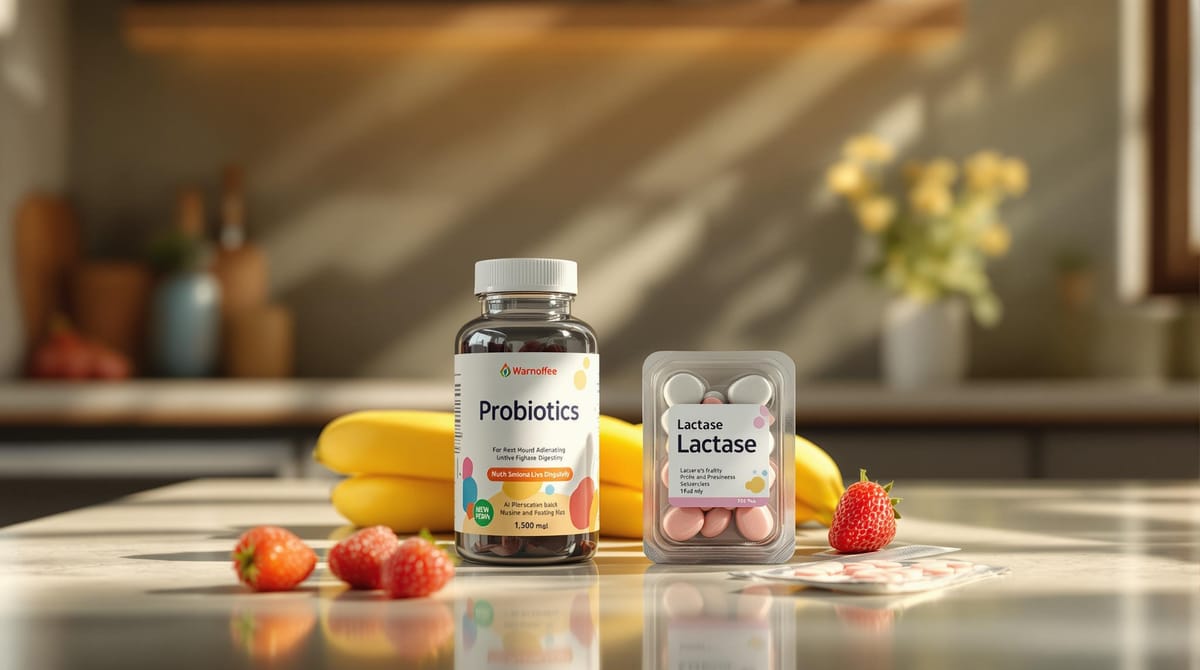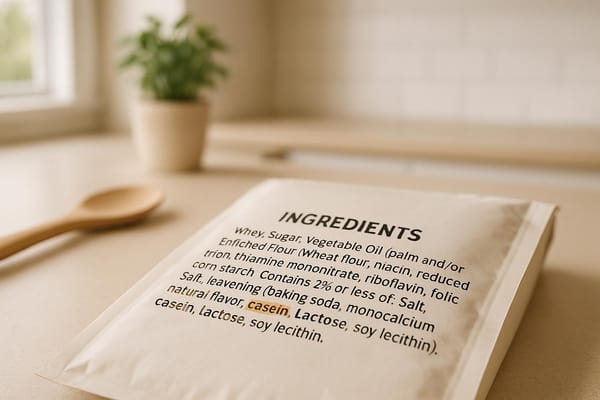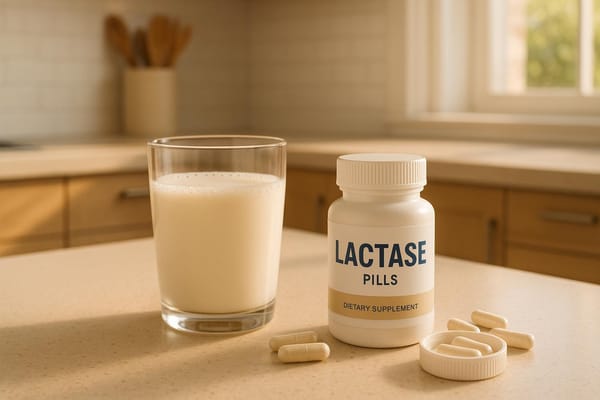How to Pair Probiotics with Lactase Pills
Learn how to effectively combine lactase pills and probiotics to ease lactose digestion and improve gut health for lactose intolerance.

Struggling with lactose intolerance? Combining lactase pills and probiotics can make digesting dairy easier. Lactase pills break down lactose in the upper digestive tract, while probiotics like Lactobacillus casei Shirota and Bifidobacterium breve Yakult improve gut health and long-term lactose digestion. Research shows that 85.2% of people with lactose intolerance noticed improvements within two weeks of using probiotics.
Key Steps to Manage Dairy Digestion:
- Choose the right lactase pills: Look for at least 25,000 FCC units of lactase, plus protease and lipase for complete dairy digestion.
- Pick effective probiotics: Use strains like L. casei Shirota and B. breve Yakult with 10⁷–10⁹ CFU per strain.
- Timing is crucial: Take lactase pills with your first bite of dairy and probiotics daily on an empty stomach.
- Start small: Begin with low-lactose foods (e.g., hard cheese, yogurt) and gradually reintroduce other dairy products.
Follow a consistent supplement routine, track your symptoms, and consult a doctor if issues persist. This approach can help you enjoy dairy more comfortably.
The Science Behind Lactose Intolerance
What Happens When You're Lactose Intolerant
Lactose intolerance happens when your body doesn't produce enough lactase, the enzyme needed to break down lactose. As a result, lactose ferments in the colon, causing symptoms like bloating, gas, and diarrhea [2]. This condition is especially common among certain ethnic groups, making it a frequent digestive issue [1].
How Lactase Supplements Help
Lactase supplements work by replacing the enzyme your body lacks. They break down lactose into simpler sugars - glucose and galactose - that are easier for your body to absorb. This process takes place in the upper digestive tract, where timing is key for proper digestion. A formula combining 27,000 FCC units of lactase with protease and lipase enzymes provides more complete dairy digestion by addressing lactose and other dairy components that might cause discomfort.
The Role of Probiotics in Digestion
Probiotics contribute to better lactose digestion in several ways. Strains like Lactobacillus casei Shirota and Bifidobacterium breve Yakult aid in breaking down lactose and improving gut health [2]. Research has shown that 85.2% of individuals with secondary lactase deficiency saw noticeable improvements after just 14 days of using probiotics [3].
The effects of probiotics can last well beyond their use. Studies reveal that taking probiotics for 4 weeks can result in benefits that continue for at least 3 months after stopping supplementation [2]. This indicates that probiotics may not only provide relief but also help rebuild your natural ability to process dairy.
Knowing how these supplements work can guide you in selecting the right options to support your digestion.
Probiotics as a treatment option for lactose intolerance
Picking Your Supplements
Understanding the role of lactose intolerance and probiotics can help you choose supplements that work best for your needs.
What to Look for in Lactase Pills
When picking lactase supplements, the strength of the enzymes and their formulation are key. Here's what to check for to aid in digesting dairy:
| Enzyme Type | Recommended Strength | Purpose |
|---|---|---|
| Lactase | 25,000+ FCC units | Breaks down lactose (milk sugar) |
| Protease | 20,000+ FCC units | Helps digest milk proteins |
| Lipase | 1,000+ FCC units | Assists in processing dairy fats |
For example, milktab's triple-enzyme formula delivers 27,000 FCC units of lactase, 22,000 FCC units of protease, and 1,000 FCC units of lipase, providing well-rounded support for dairy digestion. Look for supplements that have been tested by third-party organizations and are free from common allergens. Certifications such as vegan, non-GMO, and FODMAP-free ensure they align with specific dietary needs.
Choosing the Right Probiotics
Probiotics designed for dairy digestion focus on specific strains and concentrations. Some of the most effective strains include:
- Lactobacillus casei Shirota: Aids in breaking down lactose and promotes gut health.
- Bifidobacterium breve Yakult: Improves overall lactose digestion.
Probiotics with 10^7–10^9 CFU (Colony Forming Units) per strain are considered effective for supporting lactose digestion [2]. Research indicates that 85.2% of people with secondary lactase deficiency noticed improvements after just two weeks of probiotic use [3]. Products like Digestive Advantage Lactose Intolerance combine probiotics with lactase for added support [1].
Once you've selected your supplements, using them correctly and at the right time will help you get the most out of them.
Using Both Supplements Together
Managing dairy digestion effectively involves using lactase pills and probiotics at the right times to minimize symptoms like bloating and discomfort.
When to Take Lactase Pills
Take lactase pills just before or with your first bite of dairy-containing foods. For example, products like milktab, which contain 27,000 FCC units of lactase per pill, usually require only one tablet for most dairy servings.
| Dairy Product | Recommended Timing | Additional Notes |
|---|---|---|
| Fresh Milk/Ice Cream | Right before consumption | Larger servings might require an extra pill |
| Hard Cheese | With the first bite | Lower lactose levels mean less enzyme is needed |
| Yogurt | 5 minutes before | Fermented dairy typically needs less enzyme help |
Lactase pills work immediately, but probiotics take a different path, focusing on long-term gut health.
Best Times for Probiotic Doses
Daily use is key for probiotics to be effective. For the best absorption, follow these guidelines:
- Take probiotics on an empty stomach, about 30 minutes before meals.
- Space them at least 2 hours apart from lactase supplements.
- Stick to a consistent time each day for your doses.
Creating a Supplement Schedule
A well-planned routine can maximize the benefits of both supplements.
Morning:
- Take a probiotic 30 minutes before breakfast. Use a lactase pill if you're having dairy.
Afternoon/Evening:
- Take a second probiotic dose before dinner.
- Keep lactase pills with you for any unexpected dairy intake.
Track your progress by keeping a symptom diary during the first few weeks. This can help you adjust your schedule based on how your body reacts. If digestive issues persist despite following the plan, consult your healthcare provider for further guidance.
Once your routine is set, you can start reintroducing dairy gradually while observing how your body responds.
Starting with Dairy Foods
Begin with Low-Lactose Options
Start with dairy products that are easier to digest, such as hard cheeses and yogurt. These naturally support digestion and can be paired with lactase pills or probiotics to make the process even smoother.
| Dairy Product | Lactose Level | Suggested Portion |
|---|---|---|
| Hard Aged Cheese | Very Low | 1 oz (28g) |
| Greek Yogurt | Low-Medium | ½ cup (120g) |
| Cottage Cheese | Medium | ¼ cup (60g) |
Monitor Your Body's Reactions
Keep a daily log to track how your body responds. Include:
- The type and amount of dairy consumed
- Time of day you ate it
- Any supplements taken (with dosage and timing)
- Digestive symptoms (if any)
- How long and how intense the symptoms were
Research indicates that 85.2% of individuals improved their lactose tolerance by combining structured tracking with proper supplement use [3].
Gradually Expand Your Choices
Once you’ve successfully tolerated low-lactose options for a week, slowly add other dairy products to your diet:
- Weeks 1-2: Stick to hard cheeses and yogurt
- Weeks 3-4: Introduce small portions of milk (2-4 oz)
- Weeks 5-6: Try soft cheeses or ice cream
- Week 7 and beyond: Experiment with cream-based products
If you encounter any major discomfort, scale back to a portion size that worked for you and check in with a healthcare provider before moving forward.
After figuring out which dairy products suit you best, sticking to a routine can help maintain better digestive health in the long run.
Long-Term Digestive Care
Keep a Regular Schedule
Managing lactose intolerance over the long term relies heavily on consistency. To get the best results:
- Take supplements like lactase pills and probiotics at the same time daily, ideally with meals.
- Store supplements properly in a cool, dry place to keep them effective.
- Set reminders to help you stick to your routine without forgetting.
Your diet also plays a big role in supporting your digestive health over time.
Foods That Support Digestion
Choosing the right foods can work alongside your supplements to improve digestion:
| Food Category | Examples | How They Help |
|---|---|---|
| Prebiotic & Fermented Foods | Bananas, Garlic, Kimchi | Encourage healthy probiotic activity |
| Fiber-Rich Foods | Whole grains, Legumes | Maintain a balanced gut bacteria ecosystem |
Adding these foods to your meals can boost the benefits of your lactase pills and probiotics, helping you see better results. However, there are times when dietary changes and supplements may not be enough.
Signs to Call Your Doctor
Sometimes, symptoms may point to more serious issues. Seek medical advice if you notice:
- Severe bloating or pain that lasts more than 24 hours.
- Blood in your stool or unexplained weight loss.
- No improvement after 4-6 weeks of consistent supplement use.
"Symptoms such as persistent bloating, severe abdominal pain, diarrhea, or blood in the stool require immediate medical attention. These could be indicative of underlying conditions like small intestine bacterial overgrowth (SIBO) or other gastrointestinal issues that need professional diagnosis and treatment" [3]
If your symptoms worsen despite following a consistent supplement and diet plan, it might signal a more complex issue that needs a different approach. Regular check-ins with your healthcare provider can ensure your strategy stays effective and safe over time.
Conclusion
Using probiotics alongside lactase supplements can make a noticeable difference in how the body digests dairy, aiding lactose breakdown throughout the digestive system [1]. Enzyme blends offer targeted support, while probiotics contribute to maintaining a balanced gut environment, working together to promote better digestion.
Taking lactase pills with dairy and sticking to a regular probiotic regimen can provide strong digestive support. For instance, 85.2% of individuals reported improvements within two weeks of using these supplements together [3]. Following the recommended steps can help ease the process of reintroducing dairy into your diet.
"Four-week consumption of a probiotic combination of L casei Shirota and B breve Yakult seems to improve symptoms and decrease hydrogen production intake in lactose-intolerant patients. These effects may persist for at least 3 months after suspension of probiotic consumption." [2]
FAQs
Does Lactaid interfere with probiotics?
Lactase supplements and probiotics actually complement each other to help with dairy digestion. Lactase breaks down lactose, while probiotics, like Lactobacillus casei Shirota and Bifidobacterium breve Yakult, support gut health and improve lactose digestion [2]. Together, they offer a well-rounded approach to managing lactose intolerance.
For best results, take lactase pills with dairy products and probiotics daily. Pay attention to how your body responds. You might also explore enzyme blends that provide additional digestive support. Research shows that 85.2% of individuals experienced symptom relief within two weeks when combining probiotics with lactase supplements [3].



